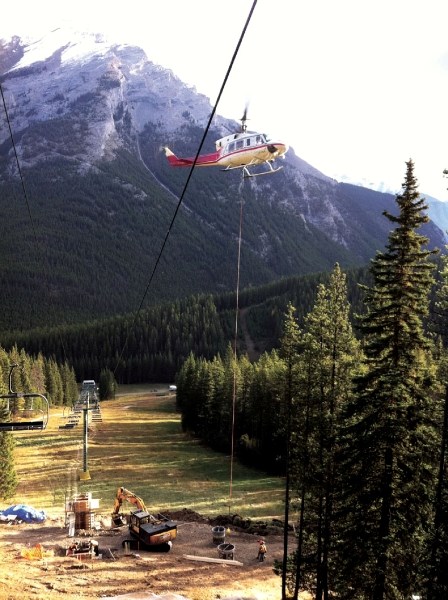Mount Norquay ski hill is prepared to give up 44 per cent of its current lease in exchange for Parks Canada allowing it to develop summer uses.
The changes in lease and conditions for summer uses, including via ferrata if approved by Banff’s superintendent as a new use, form part of approved site guidelines for development and use released this week.
In addition to the ability to attract 500 more users to the ski hill each day in winter, the allowance for summer use of a ski lift to the tea house opens the door for 16,000 additional people at the ski hill between June and October.
Superintendent Pam Veinotte said Parks Canada ski area management guidelines passed in 2006 set out that summer use is possible and the guidelines ensure significant cumulative and tangible improvements to ecological integrity must occur in exchange.
“I have to say reconfiguring the leasehold to remove an area deemed more sensitive is a substantial environmental gain,” she said, adding any proposals for summer use would also have to minimize its effects as set out in the policy. “We don’t diminish the potential impact summer use may have, but that is why the site guidelines have the parameters it does.
“Any impacts will have to mitigated and overall the site guidelines ensure a positive net environmental gain, not only locally to the ski area, but more broadly on the landscape.”
While 44 per cent of the lease is to be given up by the company, only 19 per cent of that area represents a substantial environmental gain. That includes decommissioning of the ski out and removal of part of the lease at the base of Stoney Squaw for improvement to the Cascade wildlife corridor.
Veinotte said that 19 per cent of the area will become declared wilderness under the Canadian National Parks Act.
Another key requirement for summer use is that visitors must arrive to Norquay by some form of public transportation to minimize the amount of vehicle traffic and disturbance on the access road, which transects an important wildlife corridor.
Veinotte said the guidelines represent a principled and disciplined approach and recognizes that policy evolves over time and needs to take into consideration new information and data that is available.
“It takes into consideration current environmental conditions and all the initiatives in the ‘90s and to date in regards to the Cascade wildlife corridor and removal of things like the cadet camp and the garbage dump,” she said. “The important benefit of the site guidelines is they establish permanent negotiated growth limits.
“The way those growth limits become permanent is they will become part of a new lease.”
The approval by Parks Canada CEO Alan Latourelle makes Norquay the first ski hill operation in Banff National Park to get approved site guidelines.
The documents set the parameters and conditions to guide future development and use at Norquay and is a significant commitment by its owners, said Veinotte.
The goal of the ski area management guidelines, she added, are to create land use certainty that maintains or restores ecological integrity, creates memorable visitor experiences and learning opportunity and provides certainty to ski areas for business planning in support of economically healthy operations.
“The overarching goal is this concept of land use certainty both for the ski hill and the park,” she said.
Norquay manager Peter Sudermann said giving up part of the ski hill’s lease is a business risk and one that he hopes will see returns over the next couple of years.
“We have to give up something to gain something and hopefully both sides come out with positive benefits,” he said.
Sudermann said the ability to offer new activities in summer at the ski hill offsets the fact that winter operations are capital intensive for the business.
The approval of the site guidelines is not the final hoop Norquay needs to jump through to offer summer activities.
The document belongs to Parks Canada and is at a higher policy level. Now with it in place, Norquay may develop a long-range plan with proposals for development and use that are in line with the guidelines.
If that is approved after stakeholder input and review under the Canadian Environmental Assessment Act, then Norquay may apply for specific development approvals and permits.
“Now it is up to Norquay to work on and bring forward its long-range plan showing how it meets the parameters and conditions of the site guidelines,” Veinotte said, adding proposals must meet certain criteria, including protecting habitat, minimizing disturbances, concentrating people in certain areas and separating people from wildlife.
An array of mitigations are provided in the guidelines and she said collectively these will ensure ecological integrity is maintained and in some areas improved.
In order to consider summer uses, Norquay would be required to limit its season of operation to mid June through October and between 9 a.m. and 2.5 hours before sunset.
It would also have to fence the base area to separate human use from areas critical for wildlife and no hiking or other activity, particularly mountain biking, would be allowed mid-slope.
Currently, Norquay has a lease representing 300.1 hectares, but the site guidelines propose a 166.9 hectare lease, a reduction of 133.2 hectares.
The guidelines also establish growth limits. The developed area would be limited to 164 hectares, a decrease of six hectares. Ski terrain would be limited to 99 hectares, an increase of 15 hectares. And commercial space would be limited to 4,250 square metres, an increase of 1,222 square metres.
The limits are based on several factors, including a design capacity for a maximum of 3,800 skiers a day.
Potential changes include new lifts, lift replacement and realignment, new runs, widening of current runs, new glading, expansion of snowmaking and expansion of the day lodge and tea house.




